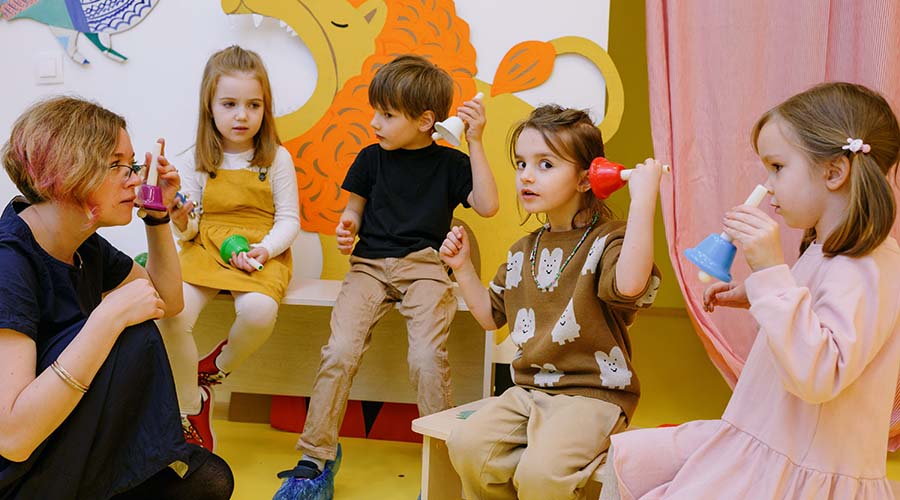settings
children
With Famly since
You browse the C.V. you’ve just been emailed and it’s looking really hopeful. Filling an open position in the Early Years is - without putting too fine a point on it - not always easy, but this candidate seems to fit the bill perfectly.
And, under ‘Qualifications’ they have ‘T Level, Education and Childcare, August 2022’
But what exactly is a T Level?
Well, I met with the team from NCFE, the awarding organisation and delivery partner for the Education and Childcare T Level, to find out.
Explaining everything you need to know about T levels are:
- Janet King, the Sector Manager for Education and Childcare,
- Stacy Mann, the Subject Specialist in Early Years and Childcare,
- Angie Rogers, the Subject Specialist in Teaching and Learning,
- Dawn Newman, the CACHE Alumni Communities Manager,
- Ben Bausor, the Director of Always Growing and a member of the Technical Education Advisory Board for the Education and Childcare T level.
Firstly, and most importantly, what is a T Level?
A T level is for students who are over 16 and have finished their GCSEs. It is equivalent to three A Levels and is included on the government's list of full and relevant qualifications for the Early Years. On successful completion, candidates are qualified to Level 3 and count in ratios where students have successfully achieved their T Level following the Early Years Educator Occupational Specialism.
This means that when your shiny new staff member arrives, T Level certificate in hand, they’re fully qualified.

What’s the content of the course like?
When employing any new member of staff, qualified or not, or mentoring a student in placement, it’s important to know how much they know. This will guide how you support and mentor them, and inform further professional development opportunities.
So what does the T Level course look like?
Unlike an apprenticeship or an NVQ, T Levels are mainly studied in the classroom, over a two-year period. Within that two years, students will complete a placement of 750 hours on the Early Years Occupational Specialism.
Angie explains that these hours can be achieved in a variety of ways dependent on the Training Provider’s mode of delivery, “For example it may be a 3/2 day split across the week or maybe block weeks across the year. It has also been seen as beneficial to have one week in and one week out so that the learner can have a feel of what happens over the week.”
The big ideas
The T Level qualification is arranged as a Core and Occupational Specialism:
- Core component: the knowledge and underpinning concepts, theories and principles as well as core skills for the education and childcare sector. This is assessed with 2 written exams and an employer-set project.
- Occupational specialisms*:
- Early Years Educator
- Assisting Teaching
- Supporting and Mentoring Students in Educational Settings
*Students will choose one occupational specialism.
NCFE QualHub
And, while T Level students are not required to achieve grade 4 in English and maths GCSE to pass, students will be required to work towards English, maths and digital competencies in their training. Students who do not hold the necessary English and maths qualifications for entry to the workforce will need to achieve these before they can be employed in the workforce at Level 3.
Ben explains, “At the end, students sit an exam and complete a series of assessment tasks as part of an employer set/validated project. They give candidates a scenario, so it might be that you notice a child is behind in the PSED element and you have to plan a series of activities to support them. The candidate has to draw on pedagogy they’ve learned and complete sub-tasks, like group discussions, to demonstrate how you would meet with parents.”

What if I’d like to have a T Level student do their placement at my setting?
Hosting a student for a placement at your setting is a chance to support the next generation of educators.
As Ben explains, “Having students on a placement is a great opportunity to build a partnership. It gives you a chance to see what they are really like day to day, and how well they fit into your team, a bit like a very extended interview. It also gives you the chance to learn from the student and the different ideas that they bring from their experience.”
Students are right in the middle of their learning so have access to knowledge and theory which is completely up to date, which can be a great opportunity to introduce new ideas, or spark new fire amongst more experienced team members.
Plus, you have access to the newest talent in the sector.
As Angie explains, “One of the advantages of considering employing a student after they have completed their T Level study is that the student would be very familiar with the policies and procedures of an Early Years setting, as well as having built strong relationships with children, parents and staff, so this is definitely an advantage”

What will I need to do, as a placement setting?
Although hugely worthwhile, having a student on placement at your setting is a big responsibility. Students are with you to work, but also to learn, so consider carefully your capacity to offer the time and support a student might need.
“We try to treat students like employees from the beginning of their placement with us,” explains Ben, “We interview them prior to them starting and we have an induction process that they follow. This means we can set the expectations from the beginning and give students the experience of what it will be like when they apply for jobs. We have had students do more than one placement with us, which is also great for continuity.”
As a setting and placement provider, there is free guidance available for:
- Your overall responsibilities as an employer and the legal requirements.
- How you will induct your student into your setting, including the time this takes.
- Whether or not you’d like to pay your student.
- How you’ll ensure your student has a strong, competent mentor.
- How you might plan your student’s necessary projects and activities.
- How you can contribute to your student’s end-of-placement review.
Angie explains that, as a placement setting, “You’ll be required to be positive role models, as well as provide a rich learning environment through varied experiences and appropriate responsibility. It is recommended that the student has a mentor within the setting to offer support and guidance, and so they feel a sense of belonging.”
Should you wish to find a student for your setting, you can use the gov.uk search page to find a local sixth form or college and contact them to explore opportunities.
And, if you’d like to learn more about T Levels from the experts, you can reach out to them at the addresses below:
- Janet King at janetking@NCFE.org.uk
- Stacy Mann at stacymann@NCFE.org.uk
- Angie Rogers at angierogers@NCFE.org.uk
- Dawn Newman at dawnnewman@NCFE.org.uk
Try learning journals for free
Add observations, and build digital learning journals to share with families instantly. All with your completely free 14-day trial.
Get started







.svg)
